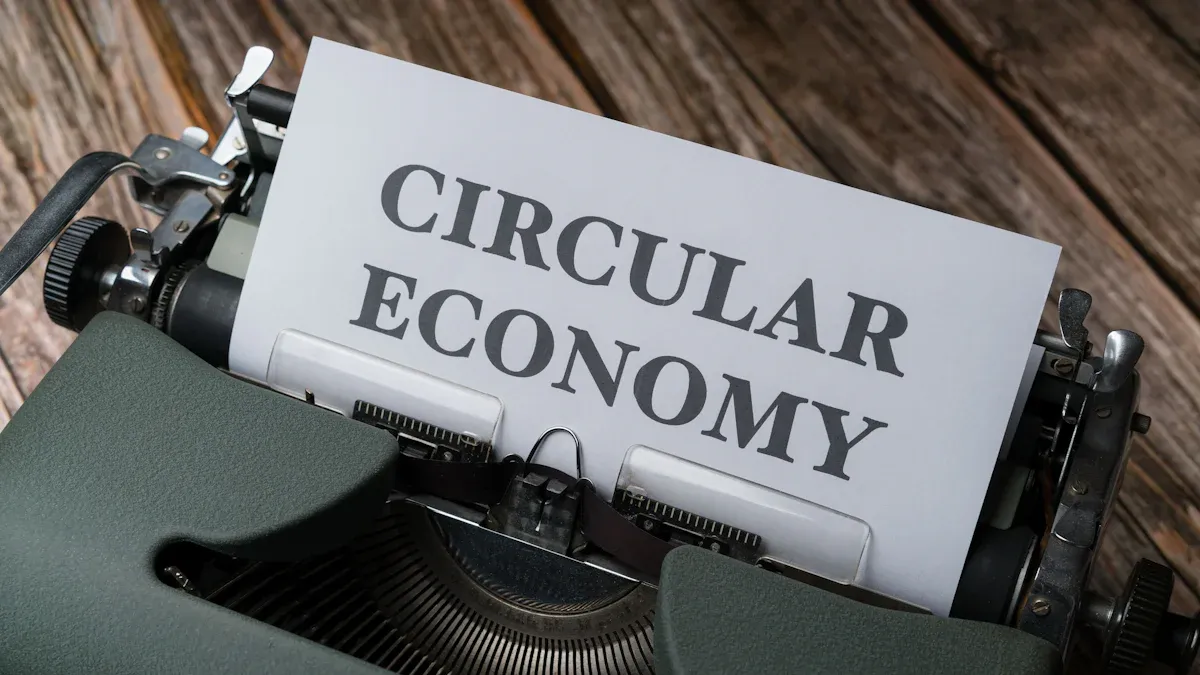Why Reverse Logistics Matters for More Than Just Retailers

Reverse logistics is very important in many industries. Companies get back useful resources, cut down on waste, and make customers happier. Best Buy’s Trade-in Program lets people swap old electronics for gift cards. This keeps devices out of landfills. Dell’s IT asset disposition program works on safe recycling and reuse. These actions show how reverse logistics helps with efficiency and being green. Every business can find new chances by using these solutions.
Key Takeaways
Reverse logistics lets companies save money. It helps them handle returns well and cut down on waste.
Businesses can make customers happier by making returns simple and quick. This makes people want to buy again.
Reverse logistics helps with sustainability goals. It recycles and reuses products. This is good for the environment.
Technology like automation and data tracking makes reverse logistics better. It helps things go faster and be more correct.
All industries, like retail and healthcare, can use reverse logistics. It helps them get value back and lower harm to the environment.
What Is Reverse Logistics?
Reverse logistics means moving products backward in the supply chain. This happens when items go back for reuse, recycling, or safe disposal. Many industries use this system to get value back and cut down on waste. It also helps them reach their sustainability goals. Companies use reverse logistics to handle returns and recalls. They also use it to fix up products. This saves money and helps the environment.
Key Processes and Activities
Reverse logistics has many steps. Each step helps make things work better and greener:
Returns Management: Companies make rules for how to take back products. They try to process returns fast so customers stay happy.
Remanufacturing, Refurbishing, and Reusing: Businesses fix or upgrade items that come back. They sell these again or use them for parts.
Recycling and Disposal: Companies recycle things that cannot be used again. They throw away waste in a safe way to help the planet.
Recall Management: Companies take back products with safety or quality problems. They do this to keep people safe and keep trust.
Tip: If companies follow these steps, they can save money. They can also send less trash to landfills and keep customers coming back.
The process usually goes like this:
Customers ask to return things, and companies check these requests.
Returned items are picked up and sent to one place.
Workers look at each item to see its condition.
Items that can be fixed are repaired or refurbished.
Some things are taken apart and rebuilt to be like new.
Things that cannot be fixed are recycled or thrown away safely.
Companies choose to give replacements, refunds, or sell fixed items.
Common Misconceptions
Some people think reverse logistics is only for store returns. But it is used for much more. Tech companies use it to handle old devices and keep data safe. Manufacturers use it to get back important parts and materials. Hospitals use reverse logistics for expired medicine and recalled tools. Some think reverse logistics costs too much or is too hard. But it often saves money and helps the planet.
Reverse logistics helps many businesses find new chances. It helps them meet green rules and build better customer relationships.
Reverse Logistics Beyond Retail
Technology and Electronics
Reverse logistics is very important for technology and electronics. Companies like Best Buy and Dell use programs to keep devices out of landfills. These programs help old electronics get used again. This gives businesses new chances to grow.
Best Buy’s Trade-in Program took in over 775,000 devices in one year. People traded in cell phones, laptops, and gaming consoles. Many of these devices were sold to new owners. This helps products last longer and is better for the planet.
Dell’s IT asset disposition program collects, cleans, and fixes hardware. The company uses these items again, which means less waste. Dell also uses recycled or renewable materials in 17.4% of its products. This helps the environment and shows how reverse logistics works in technology.
Companies that use reverse logistics in electronics earn trust from customers. They also show they care about the planet.
Manufacturing and Asset Recovery
Manufacturers use reverse logistics to get back assets and cut waste. This helps save money and is good for the environment. The table below shows what companies can gain from these actions:
Measurable Outcome | Description |
|---|---|
Cost Savings | Companies spend less on returns and waste. |
Increased Revenue from Resales | Selling fixed products brings in more money. |
Reduced Write-offs | Getting back assets means fewer losses. |
Enhanced Sustainability | Less waste and fewer new materials help the planet. |
Recovery of Initial Value | High-tech companies get back about 28% of the value of returned items. |
Reverse logistics helps manufacturers get more from each product. They save money, make more from resales, and help the planet.
Healthcare and Pharmaceuticals
Reverse logistics is also important in healthcare and pharmaceuticals. Hospitals and clinics must send back expired medicine and recalled equipment safely. This keeps patients safe and follows strict rules. Companies get valuable materials from medical devices and packaging. They also make sure dangerous waste does not hurt the planet.
Healthcare providers who use reverse logistics keep people safe and save money. They also show they care about their communities and the earth.
Benefits and Challenges
Cost Savings and Efficiency
Reverse logistics lets companies save money and work better. Businesses can fix and sell returned products again. This means less waste and more money coming in. Companies also get back value that might be lost. When they handle returns well, they spend less on extra stock and throwing things away. Many companies see big changes in how they work. For example, fixing slow parts in returns can cut costs by up to 25%.
Benefit | Description |
|---|---|
Cost Savings | Fixing and selling returned products helps save money. |
Value Recovery | Companies get back value that could be lost. |
Reduced Financial Burden | Good returns management lowers costs from extra stock and waste. |
Operational Efficiency | Solving slow spots in returns can lower costs by up to 25%. |
Tip: Companies that make returns easy can earn more and keep customers happy.
Regulatory and Environmental Impact
Reverse logistics helps companies follow rules and care for the earth. Many businesses must obey strict laws about waste and recycling. By reusing and recycling, they make less pollution and use less energy. They also use fewer natural resources. This helps fight climate change and keeps the world cleaner.
Environmental Impact | Description |
|---|---|
Smart transport and using less energy means less carbon. | |
Minimize Pollution | Reusing and recycling keeps trash out of landfills and cuts pollution. |
Conserve Resources | Using things longer means less need for new materials. |
Note: Companies that protect the earth build trust and meet what customers want.
Overcoming Obstacles
Companies face problems when starting reverse logistics. High costs, lots of returns, and hard steps can slow things down. Many companies use smart tech to fix these issues. Warehouse systems help track returns. RFID tags give updates right away. Clear steps and good training make returns easier. Good return rules and real-time tracking also help customers.
Challenge | Solution |
|---|---|
Make returns better to save money. | |
Handling Large Volumes of Returns | Use warehouse systems for better control. |
Complex Communication and Coordination | Use RFID tags for quick updates and better teamwork. |
Environmental Impact and Sustainability | Fix or recycle returned items to help the earth. |
Lack of Visibility and Data Management | Use RFID and AI for better tracking and data. |
Return Process Complexity | Make steps clear and train workers well. |
Meeting and Exceeding Customer Expectations | Share clear return rules and give real-time tracking. |
Companies that solve these problems get ahead in their industry.
Reverse Logistics and the Circular Economy

Supporting Sustainability Goals
Reverse logistics helps make a circular economy work. Companies use it to gather, sort, and send out used goods again. This system lets them get back useful materials and throw away less trash. Many businesses find new ways to use products again. This gives them more chances to grow and helps the planet.
Companies pick up used products and parts for recycling or reuse.
Businesses sort returned items to get back metals and plastics.
Firms send out fixed goods so they can be used longer.
New ways to reuse things help companies grow and protect nature.
A study from 2021 by McKinsey says reverse logistics can cut waste by over 30%. Companies also save about 15% on costs with these systems. These facts show reverse logistics helps businesses reach their green goals.
Objective | Description |
|---|---|
Environmental Care | Companies recycle or reuse products and materials, so they use fewer natural resources. |
Waste Reduction | Businesses make less waste from returns, which helps the earth. |
Resource Management | Firms control their resources and inventory better with returns. |
Customer Service Improvement | Better returns make customers happier and improve service. |
Cost Reduction | Using packaging and materials again saves money on new stuff. |
Note: Companies that use reverse logistics show they care about the earth and their customers. They build trust and meet big green and CSR goals.
Asset Recovery and Value Recapture
Asset recovery is a big benefit of reverse logistics. Companies use key performance indicators (KPIs) to see how much value they get back from returns. These KPIs help turn losses into money and make recovery better.
KPI Name | Description | Formula |
|---|---|---|
Asset Recovery Value | Shows the total value companies get back from returns. | (Total Revenue Recovered from Returns / Original Value of Returned Items) x 100 |
Resale Margin on Returned Goods | Measures how much profit companies make on resold items. | (Revenue from Resold Items - Cost of Returned Items) / Revenue from Resold Items x 100 |
Liquidation Recovery Rate | Tracks the percent of value companies get from liquidated items. | (Total Revenue from Liquidation / Original Value of Liquidated Items) x 100 |
Good returns management helps companies get more value back. Checking returned products quickly helps pick the best way to recover value. Businesses can sell, fix, refurbish, remanufacture, or recycle items. Each choice has different costs and ways to make money.
Fast checks on products help get more value back.
Selling and fixing items brings in new money.
Recycling and remanufacturing cut waste and save resources.
Tip: Companies that focus on asset recovery and value recapture get a big advantage. They save money, help the earth, and build a better name.
Technology and Innovation

Automation and Digital Tracking
Today, companies use automation and digital tracking. These tools make reverse logistics faster and smarter. AI helps with many return steps. These systems speed up returns and lower costs. Workers can focus on important jobs. Image recognition checks returned products. This means less manual checking and better accuracy. AI chatbots answer questions about returns right away. This makes things easier for customers.
Digital tracking tools help keep things organized. They record each return and give tracking IDs. These tools update item locations in real time. Automated workflows lower mistakes and move returns faster. Smart inventory systems update stock when items come back. Route and pickup tools plan the best ways to collect returns. This saves time and money.
Feature | Description |
|---|---|
Tracks every return and updates its location in real time. | |
Automated Workflows | Speeds up returns and reduces errors with set steps. |
Smart Inventory Synchronization | Updates warehouse stock as soon as items return. |
Route and Pickup Optimization | Plans the best routes for pickups, saving time and costs. |
Companies using automation and digital tracking work faster. They move parcels smarter and have fewer delays. This brings better results.
Data-Driven Optimization
Data analytics helps companies make better choices. These tools show where to improve returns and recycling. Using data helps companies work better and save money. It also helps solve problems quickly for customers.
Analytics find patterns in returns and stop fraud. They guide companies on recycling and reusing products. This helps with sustainability. Tracking key metrics shows real results.
Metric | Description |
|---|---|
Return processing time | Top companies handle returns in less than 24 hours. |
Per-item handling costs | Tracks labor, facility, and shipping costs for each return. |
Returned merchandise resale % | Shows how well companies recover value from returns. |
Total product costs and inventory | Helps companies use resources wisely. |
Faster cycles and smarter parcel movement help companies avoid slowdowns. Companies using these tools lead in reverse logistics.
Reverse logistics helps companies work better and care for the planet. It also helps them come up with new ideas. Best Buy and Dell are good examples of this:
Company | Strategy Description | Benefits |
|---|---|---|
Best Buy | Trade-In and recycling programs | Makes more money, earns trust, and brings people to stores |
Dell | Easy returns with UPS partnership | Saves money and helps with green goals |
"Spending money to lower returns can cost at first, but it should save money and make customers happier."
Companies that use these plans do better than others. They throw away less and keep customers coming back. Leaders should start looking at reverse logistics now for future success.
FAQ
What industries benefit most from reverse logistics?
Many types of businesses use reverse logistics. Technology, manufacturing, healthcare, and retail all use it. These industries get back assets and cut waste. They also save money by using reverse logistics. Every business can find new chances with these systems.
How does reverse logistics help the environment?
Reverse logistics keeps things out of landfills. Companies reuse, recycle, and fix items. This saves resources and cuts down on pollution. Businesses show they care about the earth when they use reverse logistics.
Can small businesses use reverse logistics?
Yes! Small businesses can start with easy return programs. They can work with recycling services or fix products. Even small steps help save money and build trust with customers.
What technology improves reverse logistics?
Digital tracking, automation, and data analytics help a lot. These tools make reverse logistics faster and smarter. Companies use them to track returns and lower mistakes. They also get back more value. Businesses that use technology do better than others.
See Also
Understanding How Industry Verticals Drive Market Expansion
AI-Enhanced Convenience Stores: Essential Insights for Retailers
Grocery Vending Machines Transforming Access to Retail Services
The Future of Retail Lies in AI-Driven Stores
Examining Walgreens Self-Checkout: Benefits and Obstacles in Retail
